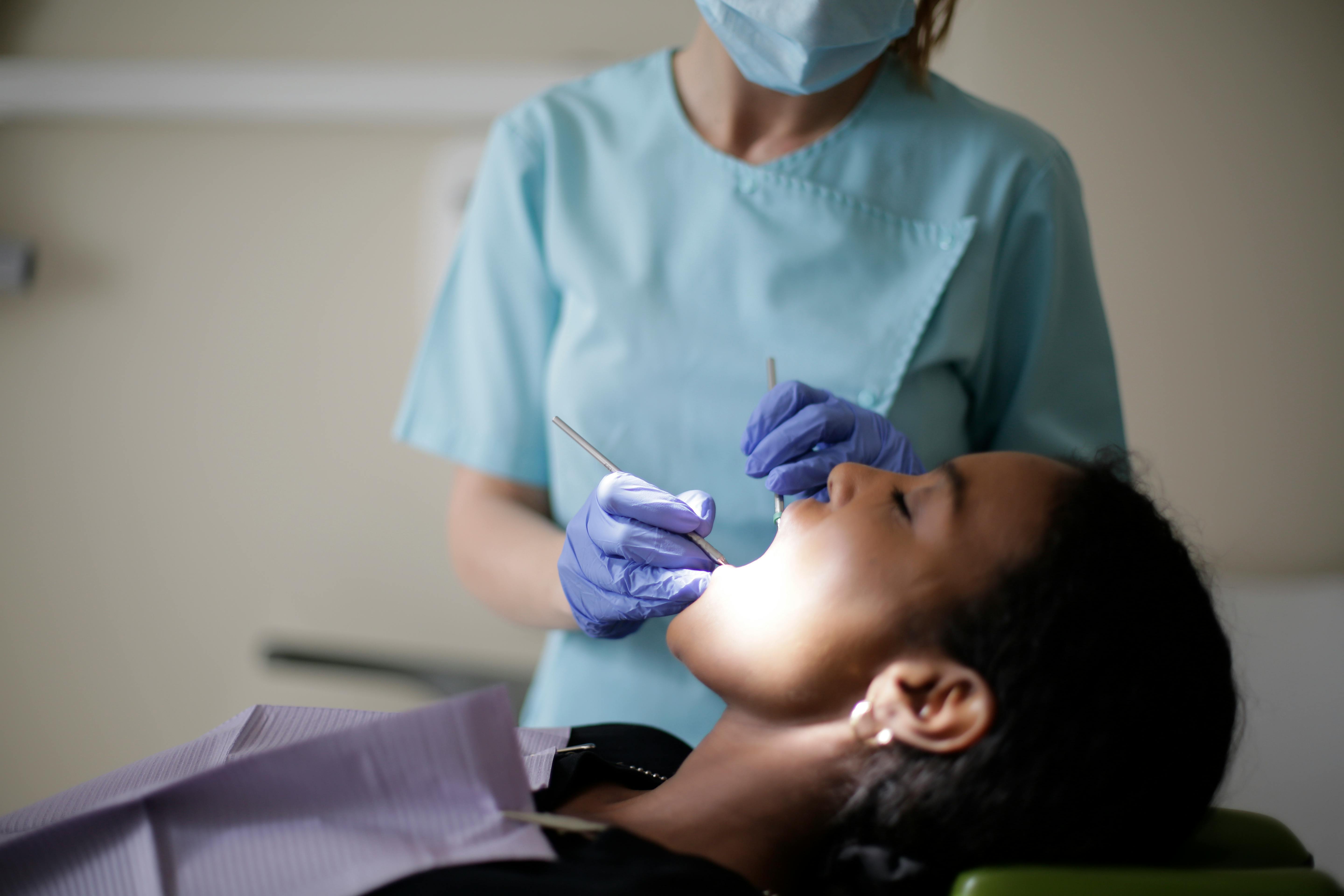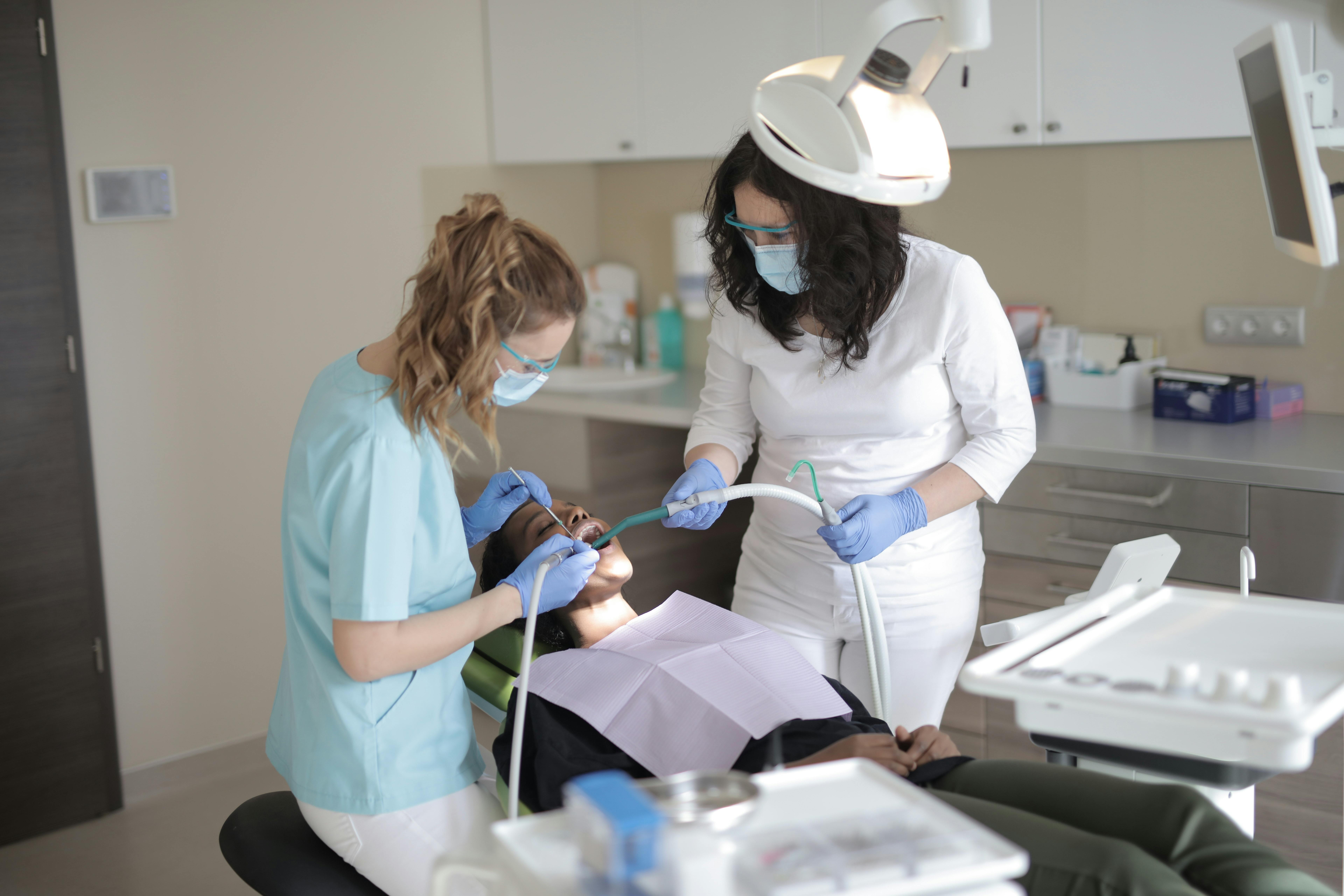Dentists use a variety of tools to help clean and maintain patients’ teeth and gums. These include specialized instruments such as scalers, curettes, and probes, as well as manual brushes and dental floss. Each tool is designed to remove plaque, debris, and tartar from the teeth, while also helping to eliminate bacteria that can cause cavities. By using a combination of these tools, dentists are able to provide comprehensive care for their patients.Dentists use a variety of tools to clean teeth, including an ultrasonic scaler, a hand scaler, a curette, an interdental brush, and a polishing cup. An ultrasonic scaler uses ultrasonic vibrations to break down and remove plaque and tartar from the surface of the teeth. A hand scaler is a small metal instrument that is used to scrape away plaque and tartar from the teeth. A curette is a curved instrument that is used to clean between the teeth and in difficult-to-reach areas of the mouth. An interdental brush is a small brush that can be used to clean between the teeth where regular brushing cannot reach. Finally, a polishing cup is used with special toothpaste to polish and buff away stains on the surface of the teeth.
Types of Tools Used by a Dentist
Dentists use a variety of tools in order to diagnose, prevent, and treat problems with the teeth and gums. These tools can range from simple hand instruments to complex technological devices. Some of the most common types of tools used by dentists include dental mirrors, forceps, scalers, probes, and drills.
Dental mirrors are used to help dentists see the back of teeth and the roof or floor of the mouth. They can also be used to reflect light onto hard-to-see areas in order to better examine them for signs of decay or other problems. Forceps are used to grasp and remove objects from the mouth such as food debris or plaque build up.
Scalers are designed to remove calculus (tartar) from teeth surfaces. This instrument is made up of two metal points that are curved at one end and sharpened at the other end. Probes are used to measure pocket depths between teeth and gums, as well as detect signs of decay or infection. Drills are used to remove decayed portions of teeth prior to filling them in with fillings or other restorative materials.
In addition to these traditional hand instruments, dentists also use a variety of high-tech tools such as digital x-rays, intraoral cameras, lasers, electric toothbrushes, 3D printing devices, and more. These modern technologies help dentists diagnose problems quickly and accurately so that they can provide patients with the best possible care.
Electric Toothbrushes
Electric toothbrushes have become increasingly popular in recent years. They offer many benefits over traditional manual toothbrushes, including improved cleaning power, the ability to set a timer to ensure proper brushing time and the convenience of easily replacing brush heads. Electric toothbrushes are a great choice for busy people who don’t have the time or inclination for proper brushing technique.
Electric toothbrushes also come in many varieties to suit different needs. Some models are designed for children, with fun designs and smaller brush heads that make it easier to reach all parts of the mouth. Other models feature more powerful motors and larger brush heads that can provide a deeper clean. Some models even include features such as pressure sensors that let you know when you’re brushing too hard and timers that help you achieve the recommended two minutes of brushing time.
No matter which electric toothbrush you choose, it’s important to use it correctly in order to get the most out of it. Make sure to use gentle pressure when brushing, as too much pressure can damage teeth and gums. Replace your brush head every three months or sooner if bristles become frayed or worn down. And remember that an electric toothbrush is not a substitute for regular flossing, so be sure to floss daily as well!
Manual Scalers
Manual scalers are mechanical devices used to measure the weight of an object. They come in a variety of shapes and sizes, from pocket scales to large industrial scales. They are often used in retail stores, manufacturing plants, and laboratories. Manual scalers can be used to weigh items such as fruits and vegetables, coins, jewelry, and industrial components. They can also be used for measuring force, torque, and acceleration. Manual scalers are usually accurate to within a few grams or ounces, depending on the model. They are typically easy to use and require little maintenance. Some models may require calibration every few months to ensure accuracy. Manual scalers are cost-effective solutions for weighing items with precision and accuracy.
When using manual scalers it is important to remember that they must be calibrated regularly in order to maintain accuracy. Additionally, they should not be overloaded as this can lead to inaccurate readings or even damage the scale itself. It is also important to keep the scale clean as dirt or dust can interfere with its accuracy. Lastly, it is important to make sure that the scale is level when using it; otherwise it may give incorrect readings due to uneven weight distribution on the platform.
Ultrasonic Scalers
Ultrasonic scalers are an essential tool for dental hygiene professionals. They are used to remove plaque and tartar from teeth, as well as to help prevent cavities. Ultrasonic scalers use high-frequency sound waves to break up the hard deposits on the teeth, making it easier to remove them with a regular toothbrush or floss. They are highly effective and very safe for both the patient and the practitioner.
The most common type of ultrasonic scaler is the hand-held device which is operated by a dental hygienist or dentist. This type of scaler is typically used in a professional dental setting and is relatively quick and easy to use. It uses water or other cleaning solutions to help break up plaque and tartar, making it easier to remove with a regular toothbrush or floss. The sound waves also help to reduce inflammation in the gums, which can help reduce sensitivity or gum pain for patients.
Ultrasonic scalers can also be used at home for personal oral care. These devices are typically smaller than those used in a professional setting, but they are still very effective at removing plaque and tartar from teeth. Home-use ultrasonic scalers may also come with additional features such as an LED light that helps you see what you’re cleaning more clearly, or even an automatic shut-off feature that helps conserve battery life.
When using an ultrasonic scaler, it’s important to follow all safety instructions carefully, as improper use can cause damage to the gums or enamel of your teeth. Additionally, these devices should only be used under the supervision of a qualified dental professional such as a dentist or hygienist who can provide guidance on proper technique and ensure that any issues with your gums or teeth are addressed immediately.
Overall, ultrasonic scalers are an excellent way to maintain good oral health by removing plaque and tartar from your teeth quickly and effectively while reducing gum inflammation at the same time. With proper use and maintenance, these devices can provide long-term benefits when it comes to your oral hygiene routine.

Air Polishers
Air polishers are ideal for polishing and finishing a variety of surfaces. These tools make it easy to achieve a high-gloss finish on any surface, allowing you to get the job done quickly and with minimal effort. An air polisher works by using compressed air to spin a disc at high speeds, which is then used to polish and buff the surface. This makes it perfect for use on hard surfaces such as concrete, stone, and metal. Air polishers are also great for removing scratches and oxidation from surfaces, as well as for creating professional finishes on furniture and other surfaces. They are lightweight and easy to use, making them ideal for both professionals and DIYers alike.
Prophy Angles and Cups
Prophy angles and cups are essential tools used for oral hygiene treatments. Prophy angles are hand-held devices with a rotating rubber cup at the end. They are used to remove plaque and food particles from the teeth during routine dental cleanings. Prophy cups come in a variety of sizes and shapes, allowing for more precise cleaning of difficult areas. The rubber cups have different textures to provide gentle, effective cleaning. Prophy angles also help to polish teeth with a special paste that is applied with the angle.
Prophy cups can be made of plastic or stainless steel, depending on the patient’s needs. Plastic prophy cups are generally softer and more pliable than metal ones, which makes them better suited for cleaning around delicate areas such as gums and bridges. Stainless steel prophy cups are harder and more abrasive, making them better for removing tough plaque deposits from hard-to-reach places like between teeth or around braces.
Prophy angles come in both manual and electric versions. Manual prophy angles require more effort on the part of the user, but they tend to be more affordable than electric models. Electric prophy angles provide greater control over pressure, speed, and other variables that can affect how much plaque is removed during a cleaning procedure.
It is important to choose the right prophy angle and cup for each patient in order to ensure effective cleaning while minimizing discomfort or damage to tooth enamel or gum tissue. When selecting a prophy angle or cup, consider factors such as size, shape, texture, material type (plastic or stainless steel), pressure control settings (manual or electric) as well as any special needs of the patient (such as braces). With careful selection of the right tools you can ensure your patients receive optimal oral hygiene care with minimal effort on your part!
Interdental Brushes and Flossers
Interdental brushes and flossers are essential for maintaining good oral hygiene. Interdental brushes are designed to reach and clean the areas between teeth that regular toothbrushes cannot reach. On the other hand, flossers are designed to remove plaque build-up between the teeth as well as along the gum line. Both interdental brushes and flossers help to prevent cavities, gingivitis, and gum disease by removing plaque and debris from the areas of your mouth that are hard to reach with a regular toothbrush.
Interdental brushes come in a variety of sizes, so it’s important to choose one that fits your mouth and teeth properly. They are also available in different shapes, such as round, cone-shaped, or tapered, depending on your needs. Flossers come in different flavors and textures too, so you can choose one that works best for you depending on your preference.
Using interdental brushes and flossers regularly can help to keep your mouth healthy by removing plaque build-up and food debris between the teeth and along the gum line. This helps to prevent cavities, gingivitis, and other dental diseases. Regular use of these tools is recommended by most dentists as part of their daily oral hygiene routine.

Conclusion
Dentists use a variety of tools to clean teeth. These tools not only help remove plaque and tartar from the surface of the teeth, but can also reach deep between teeth and beneath the gum line. Ultrasonic scalers, hand scalers, polishers and toothbrushes are all common tools used to maintain good oral hygiene. It is important to remember that regular visits to the dentist are essential for keeping your teeth and gums healthy. Regular brushing with a soft-bristled toothbrush is also recommended for optimal oral hygiene.
By utilizing these tools regularly, dentists can help keep your teeth and gums healthy, while preventing potential problems such as cavities, gum disease, and other dental issues. Keeping up with regular dental checkups and brushing twice a day will help you maintain a beautiful smile for many years to come.
